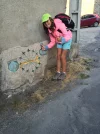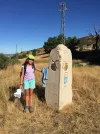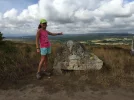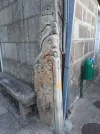gollygolly
Active Member
- Time of past OR future Camino
- 2000/13/14/15/16/17/18/19/2021/22/23/24
We have just completed our walk from Salisbury to Winchester and then to Canterbury, which was then followed by walking the Camino Ingles from La Coruña. I intend to write up about this when time allows, but thought that I would share the very welcome news that the marker stones (moines) are being returned to this stretch of the camino. I recall that when they were removed last year there was a great deal of uncertainty as to why they were removed and what was going to become of them.
When this past week we came across the workers returning them to way-mark the route, they explained that they had been removed for 'restoring'. I am not sure how these granite marker stones would require 'restoring', though they had been cleaned up and in my own looking at them I believe that the arrow indicating the direction has been carved into the granite and then painted yellow. The text 'Galicia' was, I recall, already there.
As we passed the ceramic tile with the yellow 'concha' was being added to the newly placed stones, and is always placed with the focus point on the left of the stone. It does not indicate the direction to Santiago ~ which is a pity IMHO. I rather like the idea that the focus point is Santiago itself and the nine lines leading from it show the different caminos leading to Santiago.
Attached are a couple of images, one showing the lorry carrying the stones, the other showing my daughter with the person responsible for placing the ceramic tiles within the recess.
Anyway, hurrah that these marker stones are being returned to indicate the route, even if the placement is slightly haphazard.
When this past week we came across the workers returning them to way-mark the route, they explained that they had been removed for 'restoring'. I am not sure how these granite marker stones would require 'restoring', though they had been cleaned up and in my own looking at them I believe that the arrow indicating the direction has been carved into the granite and then painted yellow. The text 'Galicia' was, I recall, already there.
As we passed the ceramic tile with the yellow 'concha' was being added to the newly placed stones, and is always placed with the focus point on the left of the stone. It does not indicate the direction to Santiago ~ which is a pity IMHO. I rather like the idea that the focus point is Santiago itself and the nine lines leading from it show the different caminos leading to Santiago.
Attached are a couple of images, one showing the lorry carrying the stones, the other showing my daughter with the person responsible for placing the ceramic tiles within the recess.
Anyway, hurrah that these marker stones are being returned to indicate the route, even if the placement is slightly haphazard.























